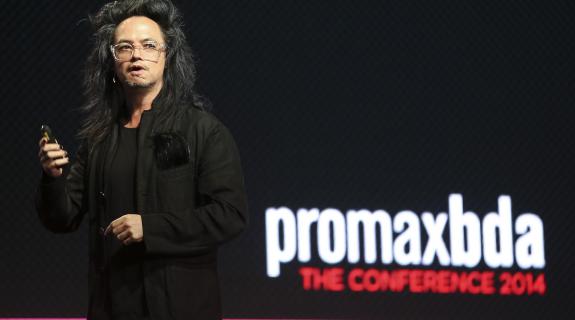A vision in spiky black hair and zebra pants, AOL’s Digital Prophet David Shing starts blasting you with ideas the moment he steps out on stage.
They’re fast, they’re furious, and they don’t come in any specific order. At the end, you feel energized and interested even if you aren’t quite sure what you just learned.
But if you listen closely enough, he’s telling you what’s coming next, what to pay attention to, and how to reach your audience in new, cutting edge ways.
And there are a few trends to pay attention to, according to Shing, addressing the opening session of the The Conference 2014 in New York City.
1) Share. “What we are trying to do with these amazing digital experiences is get people to pass them on,” Shing said. “Marketing will follow audience behavior and audiences are outpacing marketers. We’re trying to get people to recommend brands over advertising to them. We need to move away from generic advertising. The power of social is telling us that.”
Social on the Web used to be about getting people to friend you or like your posts. Now it’s about taking your content and sharing it all over the place. Amplify is the word of the day.
2) Along those lines, “we should move away from behavioral targeting into action-based specifics,” he said.
One example of that is Web-to-mobile targeting, in which advertising search engines take someone’s previous action and applies it to his next action. For example, let’s say Joe Browser searches for adidas online, doesn’t buy anything, and then heads over to Facebook. He shouldn’t be surprised to then see an ad for adidas shoes pop up in Facebook. Taking that further, perhaps a nearby store that sells adidas sends him a coupon on new shows and a discount on Uber to get there.
3) Supplement your paid media with authentic marketing, using social media and other platforms to connect with communities. “What are the sum of the totals of the whole conversation you are trying to create with your brand?” asked Shing.
4) Your brand is now experience. To illustrate this concept, Shing showed a video of soccer fans posing for selfies in a photo booth only to be surprised by David Beckham popping out from behind a corner. That led to crying and screams from the fans and kisses and hugs from the soccer star, as well as lots of much-better selfies than participants had originally expected.
And while “Beckham does not work for free,” said Shing, that promotion got the adidas brand prominently in front of lots of people when that video went viral.
5) Get to know your new customer.
“The audience we are now in front of is absolutely composed of renegades, revolutionaries, extroverts. They have more access to tools, amplification and audiences than we’ve ever seen before,” said Shing.
And brands are doing this as well. Zappos, a shoe-delivery company, is also offering its customers styling advice. “It’s authentic, action-based, conversational marketing.”
6) Wearables are coming, if they aren’t already here. People will use watches, glasses, wristbands that turn into styluses to stay in touch with themselves and the world around them.
“They will have built-in intelligence with less searching and more pushing. They will bring consumers this thing called the wearable Web. It’s yet another experience that takes us away from the mobile phone.”
7) Video is everywhere.
“In the future, it’s all about video,” said Shing. “We really love video. Globally, 90% of people watch video, 95% of people stream video and 82% play videos through to the end. We are moving into this world of show me. Who would have thought you could tell stories in six seconds? We are no longer locked into 30s and 60s. We are locked into whatever want to be locked into. “
To illustrate this point, Shing showed this video of dogs driving cars. “That’s ten minutes of brand love that will never be a 30-second TV commercial. That video has been seen 100 million times.”
8) Focus on the digital native to reach everybody.
“The digital native interacts with her phone 150 times per day. If they fall in love with you digitally, they will amplify you across platforms.”
9) Know your palette.
“At the end of the day as a creative, your palette is red, blue and yellow,” said Shing. “But in the digital world your three tools to create with are technology, content and distribution. Imagination is more important than knowledge.”
And 10) Instant message means instant response. That means reacting in real-time when something is happening. Lots of brands – including Oreo, Starbucks, Air New Zealand and Play-doh – took advantage of the moment of Prince George’s birth to congratulate the royal couple while making a little brand noise at the same time.

And “Samsung won the bloody Oscars,” said Shing, when that selfie – featuring the likes of Ellen Degeneres, Bradley Cooper, Jennifer Lawrence, Brad Pitt, Lupita Nyong’o and others – went around the world after being snapped by a Samsung Galaxy S5.

In the end, Shing left attendees with six quick takeaways:
Encourage a remix culture inside of your organization, both in your brand and in your marketing budgets.
Find the right people. Influencers are alive and well across the world.
Go out to existing communities and interact with them authentically.
Make sure that your consumers own your brand.
Embrace these new platforms. In fact, call them up and see if you can be the first brand on it.
Go out and pioneer. The faster you fail, the sooner you are going to succeed. Citing Katherine Hepburn, he said: “If you obey all of the rules, you miss all of the fun.”
Image courtesy of John Minchillo (AP).
Tags:













































__twocolumncontent.jpg)











